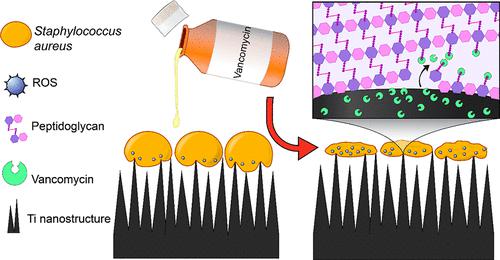当前位置:
X-MOL 学术
›
Nano Lett.
›
论文详情
Our official English website, www.x-mol.net, welcomes your
feedback! (Note: you will need to create a separate account there.)
Surfaces Containing Sharp Nanostructures Enhance Antibiotic Efficacy
Nano Letters ( IF 9.6 ) Pub Date : 2022-07-28 , DOI: 10.1021/acs.nanolett.2c02182 Richard Bright 1, 2 , Andrew Hayles 1, 2 , Jonathan Wood 1 , Dennis Palms 1 , Toby Brown 3 , Dan Barker 3 , Krasimir Vasilev 1, 2
Nano Letters ( IF 9.6 ) Pub Date : 2022-07-28 , DOI: 10.1021/acs.nanolett.2c02182 Richard Bright 1, 2 , Andrew Hayles 1, 2 , Jonathan Wood 1 , Dennis Palms 1 , Toby Brown 3 , Dan Barker 3 , Krasimir Vasilev 1, 2
Affiliation

|
The ever-increasing rate of medical device implantations is met by a proportionately high burden of implant-associated infections. To mitigate this threat, much research has been directed toward the development of antibacterial surface modifications by various means. One recent approach involves surfaces containing sharp nanostructures capable of killing bacteria upon contact. Herein, we report that the mechanical interaction between Staphylococcus aureus and such surface nanostructures leads to a sensitization of the pathogen to the glycopeptide antibiotic vancomycin. We demonstrate that this is due to cell wall damage and impeded bacterial defenses against reactive oxygen species. The results of this study promise to be impactful in the clinic, as a combination of nanostructured antibacterial surfaces and antibiotics commonly used in hospitals may improve antimicrobial therapy strategies, helping clinicians to prevent and treat implant-associated infections using reduced antibiotic concentrations instead of relying on invasive revision surgeries with often poor outcomes.
中文翻译:

含有锋利纳米结构的表面增强了抗生素的功效
不断增加的医疗器械植入率伴随着相应高的植入相关感染负担。为了减轻这种威胁,许多研究都针对通过各种方式开发抗菌表面改性。最近的一种方法涉及包含能够在接触时杀死细菌的尖锐纳米结构的表面。在此,我们报告金黄色葡萄球菌之间的机械相互作用并且这种表面纳米结构导致病原体对糖肽抗生素万古霉素敏感。我们证明这是由于细胞壁损伤和阻碍细菌对活性氧的防御。这项研究的结果有望在临床上产生影响,因为纳米结构的抗菌表面和医院常用的抗生素的组合可以改善抗菌治疗策略,帮助临床医生使用降低的抗生素浓度来预防和治疗植入物相关感染,而不是依赖侵入性翻修手术通常效果不佳。
更新日期:2022-07-28
中文翻译:

含有锋利纳米结构的表面增强了抗生素的功效
不断增加的医疗器械植入率伴随着相应高的植入相关感染负担。为了减轻这种威胁,许多研究都针对通过各种方式开发抗菌表面改性。最近的一种方法涉及包含能够在接触时杀死细菌的尖锐纳米结构的表面。在此,我们报告金黄色葡萄球菌之间的机械相互作用并且这种表面纳米结构导致病原体对糖肽抗生素万古霉素敏感。我们证明这是由于细胞壁损伤和阻碍细菌对活性氧的防御。这项研究的结果有望在临床上产生影响,因为纳米结构的抗菌表面和医院常用的抗生素的组合可以改善抗菌治疗策略,帮助临床医生使用降低的抗生素浓度来预防和治疗植入物相关感染,而不是依赖侵入性翻修手术通常效果不佳。











































 京公网安备 11010802027423号
京公网安备 11010802027423号